Ap biology macromolecules - Study guides, Class notes & Summaries
Looking for the best study guides, study notes and summaries about Ap biology macromolecules? On this page you'll find 82 study documents about Ap biology macromolecules.
Page 3 out of 82 results
Sort by
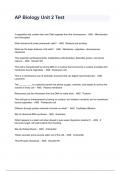
-
AP Biology Unit 2 Test Questions And Answers
- Exam (elaborations) • 4 pages • 2024
- Available in package deal
-
- $9.99
- + learn more
AP Biology Unit 2 Test Questions And Answers 2 organelles that contain their own DNA separate from the chromosome - ANS Mitochondria and chloroplast What domains fall under prokaryotic cells? - ANS Bacteria and archaea What are the basic features of all cells? - ANS Membrane, cytoplasm, chromosomes, ribosomes This organelle synthesizes lipids, metabolizes carbohydrates, detoxifies poison, and stores calcium - ANS Smooth ER This cell is characterized by having DNA in a...
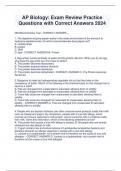
-
AP Biology: Exam Review Practice Questions with Correct Answers 2024
- Exam (elaborations) • 46 pages • 2024
-
- $17.99
- + learn more
AP Biology: Exam Review Practice Questions with Correct Answers 2024 DNA/Biochemestry Test - CORRECT ANSWER--- 1. The digestive enzyme pepsin works in the acidic environment of the stomach to hydrolyze peptide bonds. On which macromolecules does pepsin act? A. carbohydrate B. protein C. DNA D. lipid - CORRECT ANSWER-B. Protein 2. Egg whites consist primarily of water and the protein albumin. When you fry an egg, why does the egg white turn from clear to white? A. The protein bec...
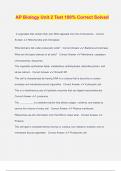
-
AP Biology Unit 2 Test 100% Correct Solved
- Exam (elaborations) • 6 pages • 2024
- Available in package deal
-
- $11.49
- + learn more
AP Biology Unit 2 Test 100% Correct Solved 2 organelles that contain their own DNA separate from the chromosome - Correct Answer ️️ -Mitochondria and chloroplast What domains fall under prokaryotic cells? - Correct Answer ️️ -Bacteria and archaea What are the basic features of all cells? - Correct Answer ️️ -Membrane, cytoplasm, chromosomes, ribosomes This organelle synthesizes lipids, metabolizes carbohydrates, detoxifies poison, and stores calcium - Correct Answer ️️ -Sm...

-
AP Biology - Unit 2 Study Guide Exam Questions With Verified Answers.
- Exam (elaborations) • 10 pages • 2024
-
- $12.49
- + learn more
AP Biology - Unit 2 Study Guide Exam Questions With Verified Answers. List the differences between a prokaryotic & a eukaryotic cell. - answerEukaryotic Cell: - nucleus (has more DNA) that's bound by a double membrane - endomembrane organelles in the cytosol (nuclear envelope, endoplasmic reticulum, Golgi apparatus, lysosomes, plasma membrane, various types of vesicles & vacuoles) - typically larger Prokaryotic Cell: - no nucleus, but has DNA (circular chromosome) that is concentrated i...

-
AP Biology: Macromolecules Exam Study Guide with Complete Solutions
- Exam (elaborations) • 7 pages • 2024
- Available in package deal
-
- $9.99
- + learn more
AP Biology: Macromolecules Exam Study Guide with Complete Solutions Macromolecules - Answer️️ -Molecules composed of thousands of atoms: the four main classes being carbohydrates, lipids, prteins, and nucleic acids Polymer - Answer️️ -Chainlike molecules, consisting of many similar or identical building blocks linked by covalent bonds. Monomer - Answer️️ -Make up polymers: connected by covalent bonds. Dehydration Synthesis - Answer️️ -(Condensation Reaction): Covalent bond...
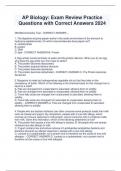
-
AP Biology: Exam Review Practice Questions with Correct Answers 2024
- Exam (elaborations) • 46 pages • 2024
- Available in package deal
-
- $16.49
- + learn more
AP Biology: Exam Review Practice Questions with Correct Answers 2024 DNA/Biochemestry Test - CORRECT ANSWER--- 1. The digestive enzyme pepsin works in the acidic environment of the stomach to hydrolyze peptide bonds. On which macromolecules does pepsin act? A. carbohydrate B. protein C. DNA D. lipid - CORRECT ANSWER-B. Protein 2. Egg whites consist primarily of water and the protein albumin. When you fry an egg, why does the egg white turn from clear to white? A. The protein bec...
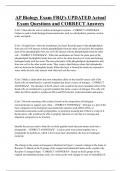
-
AP Biology Exam FRQ's UPDATED Actual Exam Questions and CORRECT Answers
- Exam (elaborations) • 4 pages • 2024
-
- $7.99
- + learn more
AP Biology Exam FRQ's UPDATED Actual Exam Questions and CORRECT Answers (Unit 1) Describe the role of carbon in biological systems. - CORRECT ANSWER- Carbon is used to build biological macromolecules such as carbohydrates, proteins, nucleic acids, and lipids. (Unit 1) Explain how, when the membranes are fused, the polar parts of the phospholipids from one cell will interact with the phospholipids from the other cell and how the nonpolar parts of the phospholipids from one cell will ...
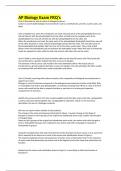
-
AP Biology Exam FRQ's (Unit 1)
- Exam (elaborations) • 3 pages • 2024
-
- $10.49
- + learn more
AP Biology Exam FRQ's (Unit 1) Describe the role of carbon in biological systems. Carbon is used to build biological macromolecules such as carbohydrates, proteins, nucleic acids, and lipids. (Unit 1) Explain how, when the membranes are fused, the polar parts of the phospholipids from one cell will interact with the phospholipids from the other cell and how the nonpolar parts of the phospholipids from one cell will interact with the phospholipids from the other cell. When the membranes ...
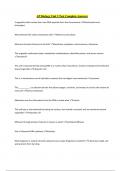
-
AP Biology Unit 2 Test Complete Answers
- Exam (elaborations) • 5 pages • 2024
- Available in package deal
-
- $9.49
- + learn more
AP Biology Unit 2 Test Complete Answers 2 organelles that contain their own DNA separate from the chromosome Mitochondria and chloroplast What domains fall under prokaryotic cells? Bacteria and archaea What are the basic features of all cells? Membrane, cytoplasm, chromosomes, ribosomes This organelle synthesizes lipids, metabolizes carbohydrates, detoxifies poison, and stores calcium Smooth ER This cell is characterized by having DNA in a nucleus that is bound by a nuclear envelop...
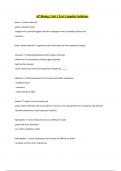
-
AP Biology Unit 1 Test Complete Solutions
- Exam (elaborations) • 14 pages • 2024
- Available in package deal
-
- $9.49
- + learn more
AP Biology Unit 1 Test Complete Solutions water -polar molecule -polar colvalent bonds -oxygen end is partial negative and the hydrogens have a partially positive end -cohesive polar covalent bonds -opposite ends of the molecule have opposite charges cohesion -H bonding between H2O creates it (sticky) -allows for the movement of water against gravity -high surface tension -water moves up a tree by transpiration (helped by ____) adhesion -H2O molecules form H bonds with other substances ...

$6.50 for your textbook summary multiplied by 100 fellow students... Do the math: that's a lot of money! Don't be a thief of your own wallet and start uploading yours now. Discover all about earning on Stuvia


